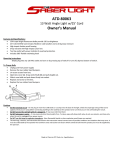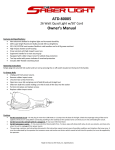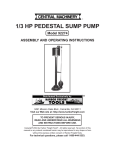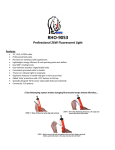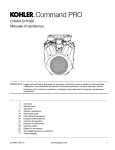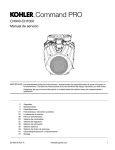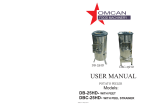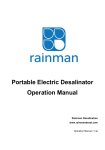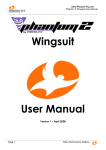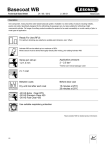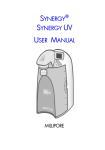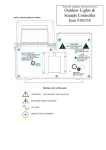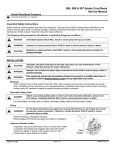Download F&Q Pumps, Inc
Transcript
USER’S MANUAL FOR F&Q SUBMERSIBLE SEWAGE PUMPS CFW40 / CFW50 / CFW50V SERIES Description F&Q submersible sewage pumps are self-contained and recommended for use in a sump or basin. The sump or basin shall be vented in accordance with local plumbing codes. Designed to pump effluent or wastewater, non-explosive and noncorrosive liquids, and shall NOT be installed in locations classified as hazardous in accordance with the United States National Electrical Code (NEC), ANSI/NFPA 70. Never install the pump in a trench, ditch, or hole with a dirt bottom; the legs will sink into the dirt and the suction will become plugged. Specifications TEMPERATURE..............104°F (40°C) Continuous UPPER BEARING...........Single row, ball design oil lubrication, IMPELLER..................... CFW40/50: 2 Vane, open radial load CFW50V: 10 Vane, Vortex LOWER BEARING..........Single row, ball design, oil lubrication, SOLIDS HANDLING.......2" (51mm) spherical radial & thrust load PAINT............................ Air dry enamel MOTOR......................... NEMA L, torque curve, oil-filled, SEAL............................. Single mechanical, Silicon Carbide, squirrel cage induction, Class B insulation oil-filled reservoir, 300 series Stainless Steel Parts SINGLE PHASE.................. Permanent Split Capacitor (PSC) CABLE ENTRY............... 20 ft. (6 m) quick disconnect cord, Includes Thermal Overload Protection in motor with plug on 120 & 240 volt, 1 phase, pressure grommet CONSTRUCTION MATERIAL……. Class 30 cast iron for motor for sealing and strain relief. house, Seal Plate and impeller OPTIONAL.... 20 ft float switch with piggy-back plug F&Q Pumps, Inc 10617 E. Rush Street S. El Monte, CA 91733 Phone: 626-455-0884 Fax: 626-448-9462 www.fandqpumps.com 1 Motor & Electrical Models Hp Volt/Ph Hz Rpm NEMA Full Locked Cord Cord Cord O.D. Start Code Load Amps Rotor Amps Size Type Inches (mm) CFW40A 4/10 115/1 60 1750 C 12.0 19.0 14/3 SJTOW 0.375 (9.5) CFW40M 4/10 115/1 60 1750 C 12.0 19.0 14/3 SJTOW 0.375 (9.5) CFW50A 1/2 115/1 60 1750 A 12.0 26.0 14/3 SJTOW 0.375 (9.5) CFW50M 1/2 115/1 60 1750 A 12.0 26.0 14/3 SJTOW 0.375 (9.5) CFW50VA 1/2 115/1 60 1750 A 12.0 26.0 14/3 SJTOW 0.375 (9.5) CFW50VM 1/2 115/1 60 1750 A 12.0 26.0 14/3 SJTOW 0.375 (9.5) CFW502VA 1/2 230/1 60 1750 A 5.5 13.0 14/3 SJTOW 0.375 (9.5) CFW502VM 1/2 230/1 60 1750 A 5.5 13.0 14/3 SJTOW 0.375 (9.5) Performance Models Hp Speed Disch. NPT Gal./Min @ Total Head in Feet Shut off 0 Ft 5 Ft 10 Ft 15 Ft 20 Ft 25 Ft CFW40A 4/10 1750 2” (51mm) 135 125 110 85 50 5 25.5 CFW40M 4/10 1750 2” (51mm) 135 125 110 85 50 5 25.5 CFW50A 1/2 1750 2” (51mm) 140 130 115 90 55 25 CFW50M 1/2 1750 2” (51mm) 140 130 115 90 55 25 CFW50VA 1/2 1750 2” (51mm) 130 120 95 65 23 23 CFW50VM 1/2 1750 2” (51mm) 130 120 95 65 23 23 CFW502VA 1/2 1750 2” (51mm) 130 120 95 65 23 23 CFW502VM 1/2 1750 2” (51mm) 130 120 95 65 23 23 Dimensions 2 General Safety Information Please read this before installing caustic,etc.) unless the pump is power source before handling or operating pump, this information specifically designed and or servicing. is provided for SAFETY and to designated to handle them. 9. Any wiring of pumps should be PREVENT EQUIPMENT 3. Make sure lifting handles are performed by a qualified PROBLEMS. To help recognize securely fastened each time electrician. this information, observe the before lifting. following symbols: 4. Do not lift pump by the power NOTE: Indicates special cord. operate a pump with a power instructions which are important 5. Do not exceed manufacturer’s cord that has frayed or brittle but not related to hazards. recommendation for maximum insulation. IMPORTANT: Indicates factors performance, as this could cause 10. Cable should be protected at concerned with assembly, the motor to overheat. all times to avoid punctures, cuts, installation, operation, or 6. Secure the pump in its operating bruises, and abrasions – inspect maintenance which could result in position so it cannot tip over, fall, frequently. damage to the machine or or slide. equipment if ignored. 7. Keep hands and feet away from 1. Most accidents can be avoided impeller when power is connected. by using COMMON SENSE. Never handle connected power cords with wet hands. Never operate a Submersible Do not wear Never 120 volt pump with a plug-in pumps are not approved for use type power cord without a loose clothing that may become in swimming pools, recreational ground fault circuit interrupter entangled in the impeller or water installations, decorative 11. other moving parts. fountains, or any installation strain relief. Do not connect Always wear appropriate safety where human contact with the conduit to pump. gear, such as safety glasses, pumped fluid is common. when working on the pump or 8. Operation against a closed piping. discharge valve will cause risk of electrical shock, all premature bearing and seal failure wiring and junction connections on any pump. should be made per the United Pumps build To reduce States National Electric Code up heat and pressure during operation. Allow time for pumps Do not remove cord and To reduce (NEC), or the Canadian to cool before handling or risk of electrical shock, pump Electrical Code (CEC) and servicing. must be properly grounded in applicable state or province and 2. Only qualified personnel should accordance with the United local codes. Requirements may install, operate, and repair pump. States National Electric Code vary depending on usage and (NEC), or the Canadian location. See wiring diagrams in Keep clear of Electrical Code (CEC) and manual. suction and discharge openings. all applicable state, and local F&Q Pumps, Inc is not responsible Do not insert fingers in pump codes and ordinances. for losses, injury, or death resulting from a failure to observe these with power connected. To reduce Do not pump Hazardous materials (flammable, risk of electrical shock, always safety precautions, misuse or abuse of pumps or equipment. disconnect the pump from the 3 Unpacking installed and tested before the system flow during pump or check Upon receiving the pump, it should long term storage begins, such valve servicing. be inspected for damage or installation will be allowed LIQUID LEVEL CONTROL shortages. If damage has occurred, provided: Figure 2 shows a typical file a claim immediately with the 1. The pump is not installed under installation for any submersible carrier that delivered the pump. If water for more than one (1) month. pump using a level control the manual is removed from the 2. Immediately upon satisfactory mounted to the discharge piping packaging, do not lose or completion of the test, the pump is with a piggy-back plug. misplace. removed, thoroughly dried, Storage repacked in the original shipping Short Term - Pumps are container, and placed in a manufactured for efficient temperature controlled storage performance following short area. inoperative periods in storage. Installation For best results, pumps can be SUBMERGENCE retained in storage, as factory It is recommended that the pump assembled, in a dry atmosphere be operated in the submerged with constant temperatures for up condition and the sump liquid level to six (6) months. should never be less than “A” Long Term - For storage of six (6) dimension in Figure 1. months, to twenty-four (24) months, the units should be stored in a temperature controlled area, a roofed-over walled enclosure that Figure 3 shows a typical provides protection from the connection for 1 phase 120V elements (rain, snow, wind-blown pumps with a piggy-back plug, for dust, etc.), and whose temperature manual and automatic operations. can be maintained between +40° F and +120° F. If extended high humidity is expected to be a problem, all exposed parts should be inspected before storage and all surfaces that have the paint FIGURE 1 scratched, damaged, or worn DISCHARGE should be recoated with a water Discharge piping should be as base, air dry enamel paint. All short as possible. Both a check surfaces should then be sprayed valve and a shut-off valve are with a rust-inhibiting oil. recommended for each pump Pump should be stored in its being used. The check valve ELECTRICAL CONNECTIONS original shipping container. On is used to prevent backflow into An acceptable motor control initial start up, rotate impeller by the sump. Excessive backflow can switch shall be provided at the hand to assure seal and impeller cause flooding and/or damage to time of installation. rotate freely. the pump. Power Cable - The cord assembly If it is required that the pump be The shut-off valve is used to stop mounted to the pump must not be 4 modified in any way except for Before operating pump, check to identification plate and record at shortening to a specific application. make sure that the voltage and the end of the manual for future Any splice between the pump and phase information stamped on the reference. the control panel must be made in pump’s identification plate INSULATION TEST accordance with all applicable matches the available power. Before the pump is put into service, electric codes. It is recommended CHECK PUMP ROTATION an insulation (megger) test should that a junction box, if used, be Before putting pump into service be performed on it. The ohm mounted outside the sump or be of for the first time, the motor rotation values as well as the volts and at least NEMA 4 construction if must be checked. Improper motor amps should be recorded. located within the wet well. Do not rotation can result in poor pump PUMP-DOWN TEST use the power cable to lift pump. performance and can damage the After the pump has been properly NOTE: The white wire is NOT a motor and/or pump. To check the wired and lowered into the basin, neutral or ground lead, but a rotation, suspend the pump freely, sump, or lift station, it is advisable power carrying conductor. momentarily apply power and to check the system by filling with observe the “kickback.” “Kickback” liquid and allowing the pump to should always be in a counter operate through it’s pumping cycle. electric shock. Do not remove clockwise direction as viewed from The time needed to empty the cord and/or strain relief. Do not the top of the pump (“kickback” system, or pump down time, connect conduit to pump. is always opposite to impeller should be recorded. Wire Size rotation). Consult a qualified electrician for “Rotation” and “kickback” direction Maintenance proper wire size. See table on is noted on the pump motor As the motor is oil filled, no page 2 for electrical information. housing. lubrication or other maintenance is Pre-operation IDENTIFICATION PLATE required. CHECK VOLTAGE AND PHASE Note the numbers on the pump’s Risk of Troubleshooting Chart Always disconnect the pump from the electrical power source before handling. If the system fails to operate properly, carefully read instructions and perform maintenance recommendations. If operating problems persist, the following chart may be of assistance in identifying and correcting them. NOTE: Not all problems and corrections will apply to each pump model. Symptom Possible Cause (s) Corrective Action Pump will not run 1. Poor electrical connection, blown fuse, 1. Check all electrical connections for security. Have tripped breaker, or other interruption of electrician measure current in motor leads. If current is within power; improper power supply ± 20% of locked rotor Amps, impeller is probably locked. If current is 0, overload may be tripped. Remove power, allow pump to cool, then recheck current 2. Switch will not activate pump or is 2. Disconnect level control. Set ohmmeter for a low range, defective such as 100 ohms full scale and connect to level control leads. Actuate level control manually and check to see that ohmmeter shows zero ohms for closed switch and full scale for open switch (Float Switch) 5 Troubleshooting Chart (Continued)Sym ptomSymptom Possible Cause (s) Corrective Action Symptom Possible Cause (s) Corrective Action Pump will not run 3. Motor or switch inoperative 3. Go to manual operation of pump 4. Float movement restricted 4. Reposition pump or clean basin as required to provide adequate clearance for float 5. Defective motor 5. Check winding insulation (Megger Test) and winding resistance. If check is outside of range, dry and recheck. If still defective, replace per service instructions 6. Insufficient liquid level 6. Make sure liquid level is at least equal to suggested turn-on point Pump hums but doesn’t 1. Incorrect voltage 1. Check all electrical connections for security run 2. Impeller jammed or loose on shaft, 2. Check impeller for freedom of operation, security, and worn, or damaged, impeller cavity or condition. Clean impeller cavity and inlet of any obstruction inlet plugged Pump delivers insufficient 1. Incorrect voltage 1. Check all electrical connections for security. capacity 2. Excessive inflow or pump not properly 2. Recheck all sizing calculations to determine sized for application proper pump size 3. Discharge restricted 3. Check discharge line for restrictions, including ice. If line passes through or into cold areas 4. Check valve stuck closed or installed 4. Remove and examine check valve for proper backwards installation and freedom of operation 5. Shut-off valve closed 5. Open valve 6. Impeller jammed or loose on shaft, worn 6. Check impeller for freedom of operation, security, and or damaged, impeller cavity or inlet plugged condition. Clean impeller cavity and inlet of any obstruction 7. Pump may be airlocked 7. Loosen union slightly to allow trapped air to escape. Verify that turn-off level of switch is set so that impeller cavity is always flooded. Clean vent hole 8. Pump running backwards 8. Check rotation. If power supply is three phase, reverse any two of three power supply leads to ensure proper impeller rotation Pump operates noisily or 1. Worn bearings, motor shaft bent vibrates excessively 1. Check winding insulation (Megger Test) and winding resistance. If check is outside of range, dry and recheck. If still defective, replace per service instructions 2. Debris in impeller cavity or broken 2. Check impeller for freedom of operation, security, and impeller condition. Clean impeller cavity and inlet of any obstruction 3. Pump running backwards 3. Check rotation. If power supply is three phase, reverse any two of three power supply leads to ensure proper impeller rotation 4. Piping attachments to building structure 4. Replace portion of discharge pipe with flexible too rigid or too loose connector Possible Cause (s) Corrective Action 6






